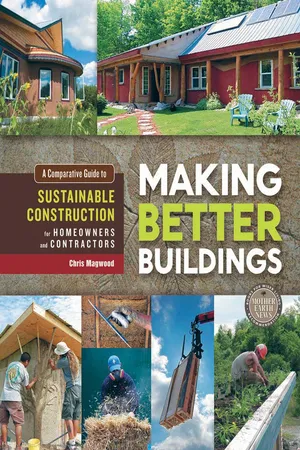![]()
1
Foundations
A BUILDING’S FOUNDATION IS EXTREMELY IMPORTANT to its longevity and performance. As such, it is often the one element where homeowners and builders will tend to choose the “tried and true” techniques and avoid “experimentation.”
This is unfortunate, because the “tried and true” methods and materials typically involve the highest environmental impacts and often the lowest energy efficiency. Most North American homes use vast amounts of concrete in their foundations, and concrete is a perfect example of the kind of energy-intensive building material that has led us to our current environmental state. The production of the portland cement that is the “glue” in concrete requires using large quantities of fuel to heat limestone to very high temperatures to change its chemical composition. In the process the carbon dioxide trapped in the stone is released into the atmosphere (along with additional CO2 released by the fuel used to heat the rock). Cement manufacture is one of the world’s leading sources of greenhouse gas emissions.
Widespread and prodigious use of concrete is only possible when vast amounts of cheap energy can be used to quarry, heat, process and transport the material. Every rise in energy costs will be reflected in a rise in concrete costs. Where once this material was the cheap, obvious answer when building foundations, it is becoming less so all the time.
In the attempt to make concrete foundations more energy efficient, concrete is often combined with foam insulations. These insulations also have dramatic environmental impacts. If we can eliminate concrete use in foundations, we also tend to eliminate foams (though not always). In the following discussions about more sustainable foundation materials, careful thought must also be applied to the insulating of these foundations, and insulation options will be addressed for each system examined.
In considering more sustainable foundation systems, a builder is forced to consider a number of challenges to typical expectations. In much of North America, foundations have been twinned with conditioned, subgrade living space: the basement. In many markets, having a basement is so normal that it can be hard to convince a homeowner to imagine a house without one. It is difficult to create a sustainable basement and — unless the home is in the driest, best draining of soils — impossible to create a basement that doesn’t rely on several layers of petrochemical products to stay dry.
As you will see in this section, there are many ways to create stable, long-lasting foundations that have reasonable environmental impacts. Most of them, however, do not make basement foundations and those that do come with significant labor requirements. The fact of the matter is that building large, conditioned basements has been a privilege of having cheap energy at our disposal. We are nearing the end of commanding that privilege.
There is one great benefit to moving away from conditioned basement foundations: cost. The cost savings that can be realized by using a sustainable, grade-based foundation are substantial, and can be used to lower the price of the entire project or traded off against sustainable materials or systems that would otherwise drive up the overall cost. It is possible to build with higher-cost renewable energy systems at a competitive cost due to savings on the foundation.
There is no doubt that the most skepticism and wariness about sustainable technologies will happen here, at the foundation. As with any change, the underlying assumption — the “foundation” — is the hardest to change. Yet this is the place that most needs changing.
Building science basics for foundations
A foundation transfers loads from the building to the ground and anchors the building to the ground. To adequately perform this role, a foundation must have enough compressive and shear strength to handle all gravity loads (the weight of roof, walls, floors) and imposed loads (occupants, furniture, snow, rain, wind, earthquakes) placed on the building and prevent the building from moving on the ground.
In areas with cold climates, the foundation must provide stability even when frost has penetrated the soil surrounding the building. When soils containing water freeze, they can expand up to 10 percent in volume and exert pressures upward of 100,000 pounds per square inch, enough to lift or shift a building. When frozen soils thaw, they can become supersaturated with water, resulting in dramatically reduced bearing capacity, enough to cause a building to sink. There are two basic strategies for achieving frost protection for a foundation:
Footings below frost depth. This strategy involves digging into undisturbed soil to a depth lower than the expected frost depth. Building codes will prescribe frost depths regionally. The foundation then becomes a wall that rests on this sub-frost footing and extends to a suitable height above grade to start the floor/walls of the building. Frost walls, basements and piers fall into this category.
Shallow, frost-protected foundations. This strategy involves installing an insulation blanket horizontally around the perimeter of the building to prevent frost from entering the soil beneath the footings. The footing can be at grade or just below grade, minimizing the amount of excavation and material required to build the foundation. Grade beams and slabs fall into this category.
Many of the materials examined in this chapter can be used for either kind of foundation, but some can only be used for one or the other.
The foundation also separates the building from the ground, and this separation must include keeping ground moisture from rising into the building and surface moisture from getting into or under the building.
The foundation must also keep out insects, rodents and other unwanted guests trying to enter the walls or the living space. These pests will vary by region, as will the strategies for keeping them out.
A foundation can p...

